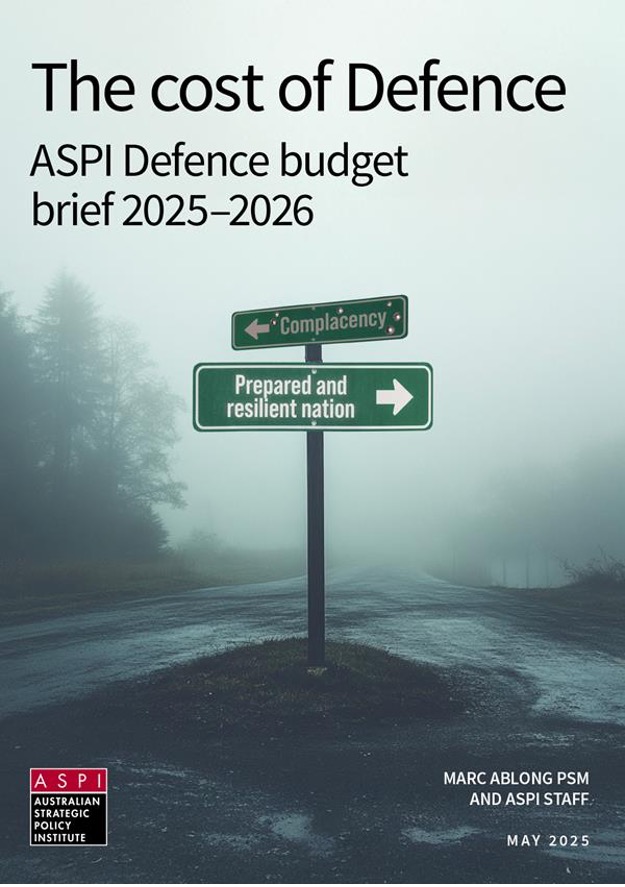
The 2025-26 Defence Budget misses a crucial opportunity to prepare the Australian Defence Force (ADF) and defence industrial base for future challenges, the Australian Strategic Policy Institute’s annual Cost of Defence analysis reveals.
The report, ‘The cost of Defence: ASPI Defence budget brief 2025–2026’ by ASPI Senior Fellow and former Deputy Secretary of the Department of Home Affairs Marc Ablong PSM and ASPI staff, was released on 29 May 2025.
As Australia faces a rapidly deteriorating strategic environment, including a major rearmament in the Indo-Pacific region, critical infrastructure vulnerabilities, cybersecurity threats and climate-fuelled disasters, the report argues that there is a major disconnect between the urgency of such threats and the level of defence funding set out in the budget.
“Australia faces a perilous strategic environment with multiple threats overlapping and, in some cases, converging. We’re confronted simultaneously by the rise of aggressive authoritarian powers, multiple conflicts around the world, persistent and evolving terrorism, foreign interference and the normalisation of cyberwarfare,” the report states.
“Without urgent, coordinated and well‐resourced responses to those challenges, Australia risks a brittle and hollowed defence force, diminished industrial sovereignty, and compromised national security in a volatile Indo‐Pacific region.”
The report examines the government’s progress with, and spending on, the 2024 National Defence Strategy (NDS) and finds that while the Australian government claims to have made a “generational investment in Australia’s Defence”, any significant uplift in defence spending is not seen until after 2028–29.
It notes that lengthy acquisition timelines for critical capabilities such as integrated air and missile defence and long‐range strike systems also risks leaving the ADF ill‐prepared for current threats and unable to keep pace with future challenges, creating a ‘no‐man’s‐land’ of preparedness.
The report also highlights that Defence needs a shift in thinking, moving away from focusing solely on countering peer or near-peer threats with similarly exquisite systems, and towards developing strategies and capabilities to address a more diffuse and asymmetric threat landscape.
“Counter-capabilities, particularly counter-drone technologies, must become a key part of any national-security strategy, let alone defence strategy, particularly as such drones wreak havoc on critical national infrastructure and government buildings,” the report notes.
At the same time, the ADF faces challenges spanning the strategic, organisational, industrial, workforce, cultural and technological domains, affecting Defence’s preparedness and the effective implementation of the NDS.
To address this complex set of challenges, the report argues that a dual strategy of filling short‐term gaps while preparing for a secure long‐term future is required, along with significant organisational reform within the Defence organisation to reduce bureaucracy, enhance agility and improve capability delivery.
Defence industry also requires capacity building, workforce development and better integration with government strategies, while workforce shortages and shortcomings in cultural reform remain critical impediments to preparedness and need to be addressed.
The report makes several recommendations for the government, including increasing defence funding to at least three per cent of GDP to reflect the reality of the threats facing Australia and reprioritising spending to enhance current force readiness.
The 2026 editions of the NDS and Integrated Investment Program should accelerate the acquisition of critical capabilities such as integrated air and missile defence, long‐range strike and autonomous systems, as well as enhanced cyber, intelligence and digital transformation initiatives to maintain strategic advantage in contested domains.
It also calls for concrete strategies and funding to build a skilled and sufficient workforce across the Australian Public Service, the ADF and the defence industry, as well as strengthening the sovereign defence industry through clear definitions and support and building stronger alliances and regional partnerships.



